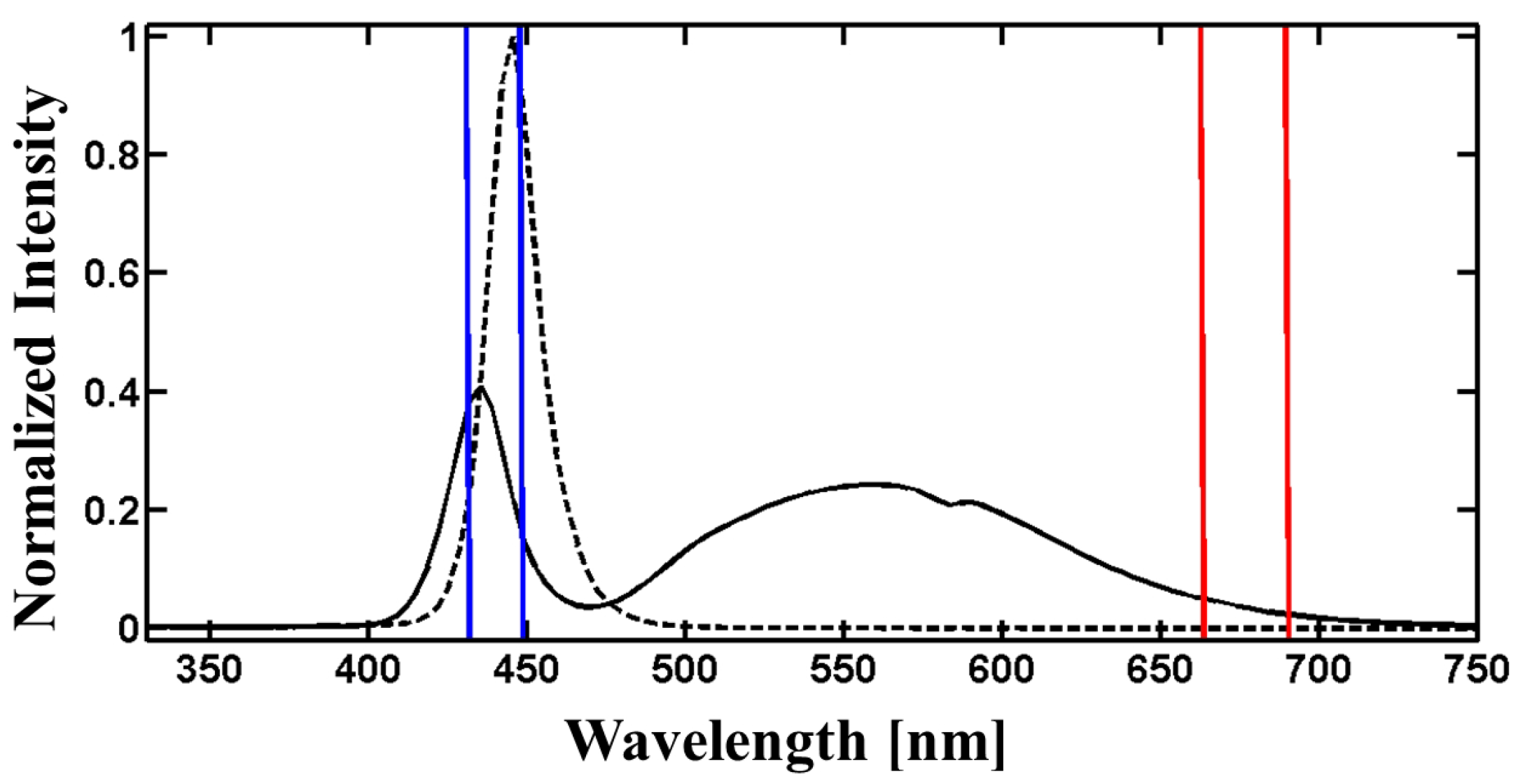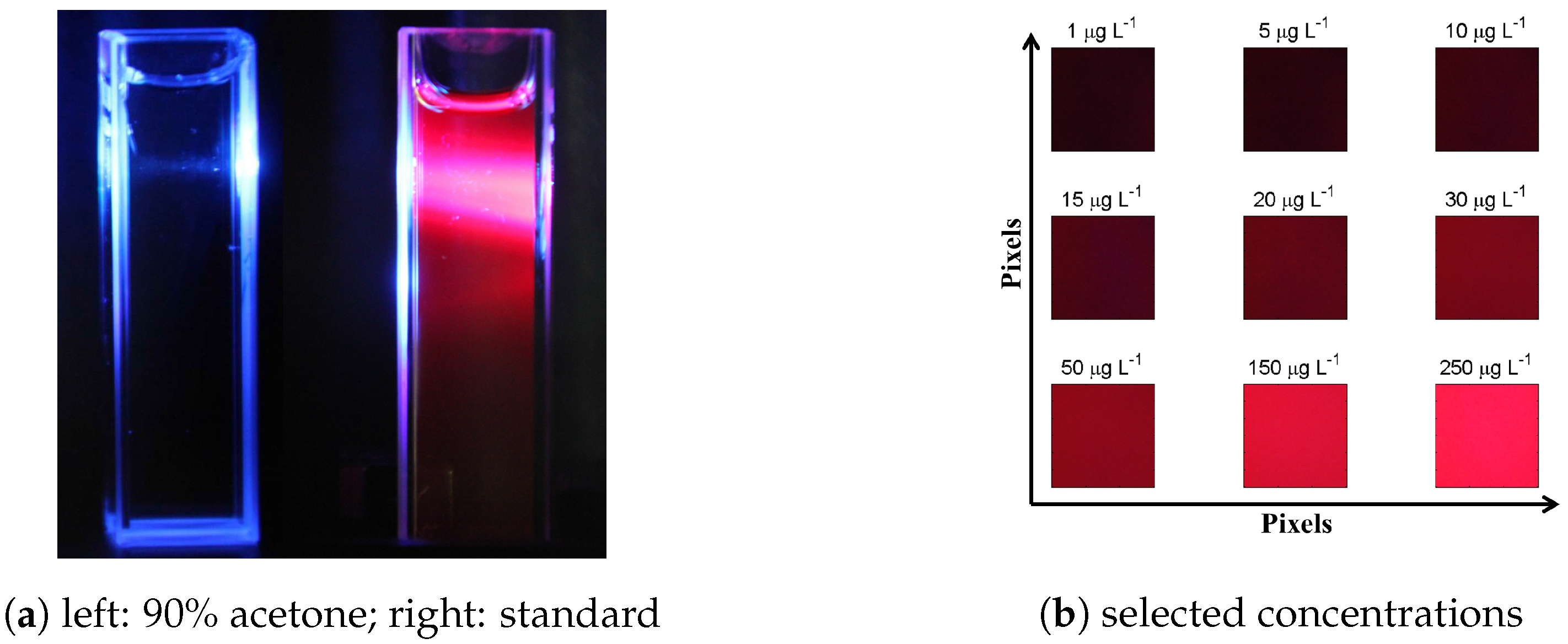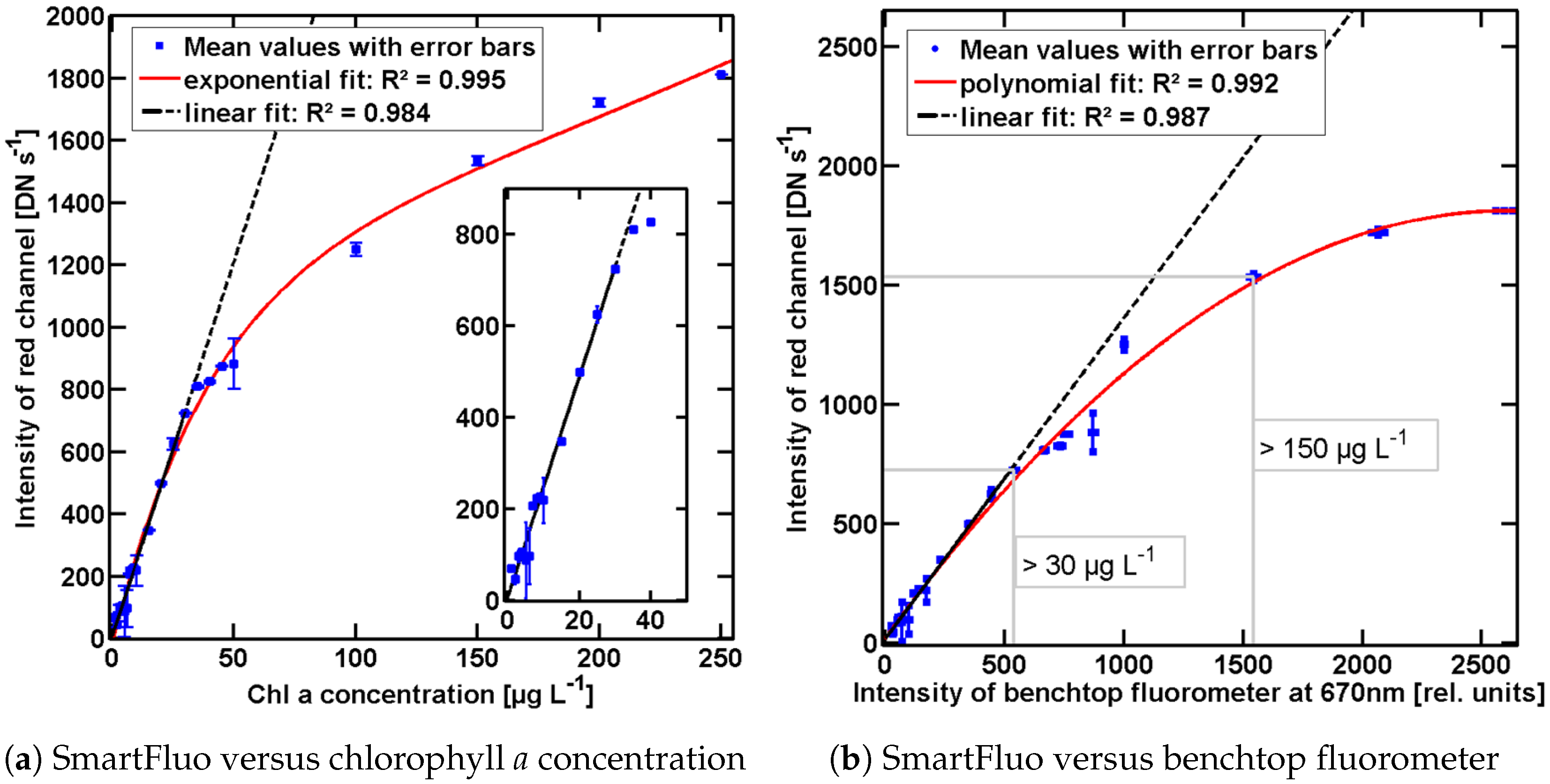SmartFluo: A Method and Affordable Adapter to Measure Chlorophyll a Fluorescence with Smartphones
Abstract
:1. Introduction
2. Method
2.1. Hardware
2.2. Algorithm
- Selection of sub image (region of interest): As the geometry of the measurement and the focus field of the camera is constant, a 300 × 300 pixel field at the centre of the image is selected to avoid catching edge effects of the cuvette. The detected signal proved to be stable over this region.
- Red channel extraction: The digital number of the red channel is determined for each 300 × 300 pixel field of the RGB images.
- Illumination time extraction: The illumination time is read out from the property information of each image and saved for further analyses.
- Intensity calculation: For each image, is calculated after Equation (2).
- Blank correction: Intensity of the sample is corrected by subtracting the intensity of a blank reference sample (base-line correction).
2.3. Laboratory Validation
3. Results
3.1. Excitation and Detection
3.2. Affordable Adapter
3.3. Laboratory Experiments—Proof of Concept
4. Discussion
5. Conclusions
Supplementary Materials
Acknowledgments
Author Contributions
Conflicts of Interest
References
- Cullen, J.J. The Deep Chlorophyll Maximum: Comparing Vertical Profiles of Chlorophyll a. Can. J. Fish. Aquat. Sci. 1982, 39, 791–803. [Google Scholar] [CrossRef]
- Klemas, V. Remote Sensing of Algal Blooms: An Overview with Case Studies. J. Coast. Res. 2012, 28, 34–43. [Google Scholar] [CrossRef]
- Behrenfeld, M.J.; O’Malley, R.T.; Siegel, D.A.; McClain, C.R.; Sarmiento, J.L.; Feldman, G.C.; Milligan, A.J.; Falkowski, P.G.; Letelier, R.M.; Boss, E.S. Climate-driven trends in contemporary ocean productivity. Nat. Lett. 2006, 444, 752–755. [Google Scholar] [CrossRef] [PubMed]
- Busch, J.A.; Zielinski, O.; Cembella, A.D. Optical assessment of harmful algal blooms (HABs). In Subsea Optics and Imaging; Woodhead Publishing Series in Electronic and Optical Materials; Woodhead Publishing: Philadelphia, PA, USA, 2013; Chapter 8; pp. 171–214. [Google Scholar]
- European Union. Marine Strategy Framework Directive. Available online: http://ec.europa.eu (accessed on 23 March 2017).
- Govindjee; Papageorgiou, G.C.; Rabinowitch, E. Chlorophyll fluorescence and photosynthesis. In Fluorescence: Theory, Instrumentation, and Practice; Marcel Dekker: Urbana, IL, USA, 1967; Chapter 12; p. 30. [Google Scholar]
- Papageorgiou, G. Chlorophyll fluorescence: An intrinsic probe of photosynthesis. In Bioenergetics of Photosynthesis, Cell Biology; Academic Press: New York, NY, USA, 1975; pp. 320–374. [Google Scholar]
- Krause, G.H.; Weis, E. Chlorophyll fluorescence and photosynthesis: The Basics. Annu. Rev. Plant Physiol. Plant Mol. Biol. 1991, 42, 313–349. [Google Scholar] [CrossRef]
- Govindjee. Sixty-three years since Kautsky: Chlorophyll a fluorescence. Aust. J. Plant Physiol. 1995, 22, 131–160. [Google Scholar] [CrossRef]
- Lakowicz, J.R. Principles of Fluorescence Spectroscopy, 3rd ed.; Springer: New York, NY, USA, 2010. [Google Scholar]
- Huot, Y.; Brown, C.A.; Cullen, J.J. New algorithms for MODIS sun-induced chlorophyll fluorescence and a comparison with present data products. Limnol. Oceanogr. Methods 2005, 3, 108–130. [Google Scholar] [CrossRef]
- Behrenfeld, M.J.; Westberry, T.K.; Boss, E.S.; O’Malley, R.T.; Siegel, D.A.; Wiggerta, J.D.; Franz, B.A.; McClain, C.R.; Feldman, G.C.; Doney, S.C.; et al. Satellite-detected fluorescence reveals global physiology of ocean phytoplankton. Biogeoscience 2009, 6, 779–794. [Google Scholar] [CrossRef]
- Kirk, J.T.O. Light and Photosynthesis in Aquatic Ecosystems, 3rd ed.; Cambridge University Press: Cambridge, UK, 2011. [Google Scholar]
- Maxwell, K.; Johnson, G.N. Chlorophyll fluorescence—A practical guide. J. Exp. Bot. 2000, 51, 659–668. [Google Scholar] [PubMed]
- Brunet, C.; Johnsen, G.; Lavaud, J.; Roy, S. Pigments and photoacclimation processes. In Phytoplankton Pigments: Characterization, Chemotaxonomy and Applications in Oceanography; Cambridge University Press: Cambridge, UK, 2011; Chapter 11; pp. 445–471. [Google Scholar]
- Lorenzen, C.J. A method for the continuous measurements of in vivo chlorophyll concentration. Deep-Sea Res. 1966, 13, 223–227. [Google Scholar] [CrossRef]
- Babin, M. Phytoplankton fluorescence: Theory, current literature and in situ measurements. In Real-time Coastal Observing Systems for Marine Ecosystem Dynamics and Harmful Algal Blooms; Unesco Publishing: Valencia, Spain, 2008; Chapter 7; pp. 237–280. [Google Scholar]
- Moore, C.; Barnard, A.; Fietzek, P.; Lewis, M.; Sosik, H.; White, S.; Zielinski, O. Optical tools for ocean monitoring and research. Ocean Sci. 2009, 5, 661–684. [Google Scholar] [CrossRef]
- Pires, M.D. Evaluation of Fluorometers for the in situ Monitoring of Chlorophyll and/or Cyanobacteria; Project Report, 1203593-000; Deltares: Delft, The Netherlands, 2010. [Google Scholar]
- Zielinski, O.; Busch, J.A.; Cembella, A.D.; Daly, K.L.; Engelbrektsson, J.; Hannides, A.K.; Schmidt, H. Detecting marine hazardous substances and organisms: Sensors for pollutants, toxins, and pathogens. Ocean Sci. 2009, 5, 329–349. [Google Scholar] [CrossRef]
- Johnsen, G.; Moline, M.M.; Pettersson, L.H.; Pinckney, J.; Pozdnyakoy, D.V.; Egeland, E.S.; Schofield, O.M. Optical monitoring of phytoplankton bloom pigment signatures. In Phytoplankton Pigments Characterization, Chemotaxonomy and Applications in Oceanography; Cambridge University Press: New York, NY, USA, 2011; Chapter 14; pp. 538–606. [Google Scholar]
- Chang, G.C.; Dickey, T.D. Interdisciplinary sampling strategies for detection and characterization of harmful algal blooms. In Real-Time Coastal Observing Systems for Marine Ecosystems Dynamics and Harmful Algal Blooms; UNESCO Publishing: Paris, France, 2008; Chapter 2; pp. 43–84. [Google Scholar]
- Busch, J.A.; Price, I.; Jeansou, E.; Zielinski, O.; van der Woerd, H.J. Citizens and satellites: Assessment of phytoplankton dynamics in a NW Mediterranean aquaculture zone. Int. J. Appl. Earth Obs. Geoinf. 2016, 47, 40–49. [Google Scholar] [CrossRef]
- Leeuw, T.; Boss, E.S.; Wright, D.L. In situ measurements of phytoplankton fluorescence using low-cost electronics. Sensors 2013, 13, 7872–7883. [Google Scholar] [CrossRef] [PubMed]
- CITCLOPS. (Citizens’ observatory for Coast and Ocean Optical Monitoring). Available online: www.citclops.eu (accessed on 23 March 2017).
- Novoa, S.; Wernand, M.R.; van der Woerd, H.J. WACODI: A generic algorithm to derive the intrinsic color of natural waters from digital images. Limnol. Oceanogr. Methods 2015, 13, 697–711. [Google Scholar] [CrossRef]
- Wright, W.D. A re-determination of the trichromatic coefficients of the spectral colours. Trans. Opt. Soc. 1929, 30, 141. [Google Scholar] [CrossRef]
- Smith, T.; Guild, J. The C.I.E. colorimetric standards and their use. Trans. Opt. Soc. 1931, 33, 73. [Google Scholar] [CrossRef]
- Fairman, H.S.; Brill, M.H.; Hemmendinger, H. How the CIE 1931 color-matching functions were derived from Wright-Guild data. Color Res. Appl. 1997, 22, 11–23. [Google Scholar] [CrossRef]
- Cullen, J.J.; Davis, R.F. The blank can make a big difference in oceanographic measurements. Limnol. Oceanogr. Bull. 2003, 12, 31–36. [Google Scholar]
- Arar, E.J.; Collins, G.B. EPA-method 445.0, In vitro Determination of Chlorophyll a and Pheophytin a in Marine and Freshwater Algae by Fluorescence. In Methods for Determination of Chemical Substances in Marine and Estuarine Matrices; United States Environmental Protection Agency: Washington, DC, USA, 1997. [Google Scholar]
- Wernand, M.R.; van der Woerd, H.J. Spectral analysis of the Forel-Ule Ocean colour comparator scale. J. Eur. Opt. Soc. Rapid Publ. 2010, 5. [Google Scholar] [CrossRef]
- Novoa, S.; Wernand, M.R.; van der Woerd, H.J. The modern Forel-Ule scale: A ‘do-it-yourself’ colour comparator for water monitoring. J. Eur. Opt. Soc. Rapid Publ. 2014, 9. [Google Scholar] [CrossRef]
- White, M.; Feighery, L.; Bowers, D.; O’Riain, G.; Bowyer, P. Using digital cameras for river plume and water quality measurements. Int. J. Remote Sens. 2005, 26, 4405–4419. [Google Scholar] [CrossRef]
- Kuo, Y.S.; Verma, S.; Schmid, T.; Dutta, P. Hijacking power and bandwidth from the mobile phone’s audio interface. In Proceedings of the First ACM Symposium on Computing for Development, London, UK, 17–18 December 2010. [Google Scholar]
- Johnsen, G.; Bricaud, A.; Nelson, N.; Prèzelin, B.B.; Bidigare, R.R. In vivo bio-optical properties of phytoplankton pigments. In Phytoplankton Pigments Characterization, Chemotaxonomy and Applications in Oceanography; Cambridge University Press: New York, NY, USA, 2011; Chapter 13; pp. 496–537. [Google Scholar]
- Welschmeyer, N.A. Fluorometric analysis of chlorophyll a in the presence of chlorophyll b and pheopigments. Limnol. Oceanogr. 1994, 39, 1985–1992. [Google Scholar] [CrossRef]
- Busch, J.A.; Bardaji, R.; Ceccaroni, L.; Friedrichs, A.; Piera, J.; Simon, C.; Thijsse, P.; Wernand, M.R.; van der Woerd, H.J.; Zielinski, O. Citizen Bio-Optical Observations from Coast- and Ocean and Their Compatibility with Ocean Colour Satellite Measurements. Remote Sens. 2016, 8, 879. [Google Scholar] [CrossRef]
- Fienen, M.N.; Lowry, C.S. Social.Water—A crowdsourcing tool for environmental data acquisition. Comput. Geosci. 2012, 49, 164–169. [Google Scholar] [CrossRef]
- Eyeonwater.Org Colour. Available online: www.eyeonwater.org/color (accessed on 23 March 2017).
- Tulloch, A.I.; Possingham, H.P.; Joseph, L.N.; Szabo, J.; Martin, T.G. Realising the full potential of citizen science monitoring programs. Biol. Conserv. 2013, 165, 128–138. [Google Scholar] [CrossRef]
- Zielinski, O. Subsea optics: An introduction. In Subsea Optics and Imaging; Woodhead Publishing Series in Electronic and Optical Materials; Woodhead Publishing: Philadelphia, PA, USA, 2013; Chapter 1; pp. 3–16. [Google Scholar]
- Beutler, M.; Wiltshire, K.; Meyer, B.; Moldaenke, C.; Lüring, C.; Meyerhöfer, M.; Hansen, U.P.; Dau, H. A fluorometric method for the differentiation of algal populations in vivo and in situ. Photosynth. Res. 2002, 72, 39–53. [Google Scholar] [CrossRef] [PubMed]





| Parameter | Instrument | Settings | Purpose |
|---|---|---|---|
| Fluorescence | Adapter | White balance: daylight; Focus: automatic; Illumination time <1 s | Method to be validated |
| Fluorescence | LS55 | : 448 nm; : 600–750 nm | |
| Gain 775 V to 950 V | Control measurements | ||
| Scan Speed: 1000 nm·min | |||
| Emission and Excitation slit: 10 nm |
| Component | Manufacturer | Price [Euro] |
|---|---|---|
| 3D printed holder | not specified | 10–50 |
| External LED | Philips Lumileds Lighting Company, Amsterdam, The Netherlands | 5.00 |
| Voltage-circuit | various | 16.63 |
| Cuvette | Brand, Wertheim, Germany | 0.11 |
| Transparency filters | Rosco, CT, USA | 10.97 |
| Total costs approximately | 33.00–73.00 | |
© 2017 by the authors. Licensee MDPI, Basel, Switzerland. This article is an open access article distributed under the terms and conditions of the Creative Commons Attribution (CC BY) license (http://creativecommons.org/licenses/by/4.0/).
Share and Cite
Friedrichs, A.; Busch, J.A.; Van der Woerd, H.J.; Zielinski, O. SmartFluo: A Method and Affordable Adapter to Measure Chlorophyll a Fluorescence with Smartphones. Sensors 2017, 17, 678. https://doi.org/10.3390/s17040678
Friedrichs A, Busch JA, Van der Woerd HJ, Zielinski O. SmartFluo: A Method and Affordable Adapter to Measure Chlorophyll a Fluorescence with Smartphones. Sensors. 2017; 17(4):678. https://doi.org/10.3390/s17040678
Chicago/Turabian StyleFriedrichs, Anna, Julia Anke Busch, Hendrik Jan Van der Woerd, and Oliver Zielinski. 2017. "SmartFluo: A Method and Affordable Adapter to Measure Chlorophyll a Fluorescence with Smartphones" Sensors 17, no. 4: 678. https://doi.org/10.3390/s17040678
APA StyleFriedrichs, A., Busch, J. A., Van der Woerd, H. J., & Zielinski, O. (2017). SmartFluo: A Method and Affordable Adapter to Measure Chlorophyll a Fluorescence with Smartphones. Sensors, 17(4), 678. https://doi.org/10.3390/s17040678






